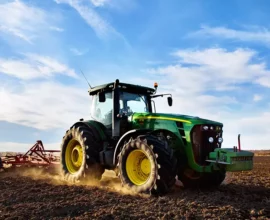Increased availability of high-speed internet in rural areas can help boost crop yields and lower fertilizer, seed, and fuel costs, according to a Federal Communications Commission study.
The report, “Impact of Broadband Penetration on U.S. Farm Productivity,” drew from FCC and Department of Agriculture county-level data on field crops like corn, cotton, hay, and soybeans.
The report found that a 1 percent increase in the number of high-speed internet connections (service speeds of at least 25 megabits per second (mbps) download and 3 mbps upload) per 1,000 households would lead to a 3.6 percent increase in corn yields and 3.8 percent increase in soybean yields.
The use of precision ag techniques with high-speed internet service allows farmers to reduce their use of fertilizer and pesticides, potentially reducing farmers’ costs and environmental impact. More precise applications of nitrogen fertilizer can reduce emissions of nitrous oxide, a powerful greenhouse gas, from fields.
The report said a 1 percent increase in internet connections would lead to a 6.5 percent decline in fertilizer expenses per operation and a 3.4 percent decrease in seed and plants expenses per farm.
“A constant theme I’ve heard is the boost in productivity that comes with the use of precision agriculture and other broadband-based technologies,” said FCC Chairman Ajit Pai.
He said the paper underscores the importance of the commission’s effort to expand broadband access in rural and underserved areas with programs like the Rural Digital Opportunity Fund. The fund is a $20.4 billion two-phase program to build high-speed internet in underserved areas over 10 years. Providers must meet certain criteria and provide fixed broadband speeds of no less than 25/3 mbps.
“Access to broadband is needed for farmers and livestock producers to implement precision agriculture practices that reduce input use, increase efficiency, and reduce agriculture’s environmental impact,” ASA CEO Steve Cenksy told Agri-Pulse. “This economic piece helps document why Congress and the Administration need to prioritize and increase investments to bring broadband to all of rural America.”
Economist Katherine LoPiccalo, who wrote the paper, works for the Consumer Financial Protection Bureau. She previously worked at the FCC. She said in the report, citing industry estimates, technological innovation made possible by precision agriculture and the deployment of broadband has “lowered farm expenses on seed, fertilizer and pesticides by an average of 15 percent, and raised crop yields by an average of 13 percent.”
LoPiccalo noted that large farms and agribusinesses are most likely to have high-speed internet service.
“Large agribusiness firms with an international scope are more likely to adopt Internet use than others whose scope remains more local,” LoPiccalo said in the study. She also said a farmer’s age and educational achievement, family size, prior exposure to computers and the internet, are other factors in broadband adoption.
Source: Agri-Pulse










